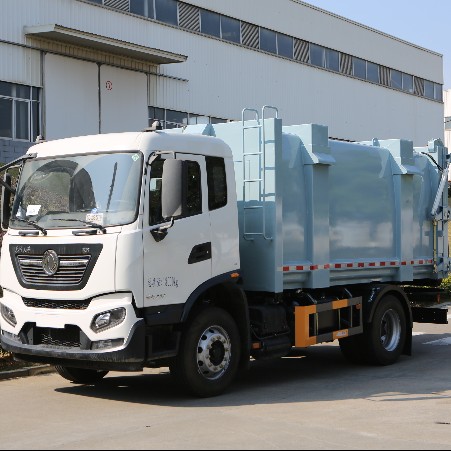Efficient waste management is critical for several reasons. Firstly, it helps mitigate the environmental impact of human activity. Proper waste disposal prevents pollution, conserves resources, and reduces greenhouse gas emissions. Secondly, it’s essential for public health and safety. Efficient waste management minimizes the risk of disease outbreaks and keeps our communities clean. Finally, it’s economically beneficial. Recycling and proper waste handling create jobs and can even turn waste into valuable resources.
One of the unsung heroes in this battle against waste is the garbage truck, a vehicle we see almost daily but rarely think about in depth. Today, we’re pulling back the curtain on the garbage truck operation process, from collection to final disposal.
Types of Garbage Trucks

Garbage trucks come in various shapes and sizes, each designed for specific tasks in the waste management process. Here are some of the most common types:
Compactor Trucks
These are the most common types of garbage trucks, equipped with a hydraulic press that compacts the waste, allowing for higher volume collection. Compactor trucks are efficient and reduce the number of trips needed to transport waste to disposal sites.
Roll-off Trucks
These trucks are designed to carry large waste containers, often used in construction and demolition sites. The containers can be rolled off the truck for easy loading and unloading.
Recycling Trucks
Recycling trucks are specialized to handle recyclable materials. They often have multiple compartments to separate different types of recyclables like paper, plastic, and glass.
Side Loader, Rear Loader, and Front Loader Trucks
These trucks differ mainly in how they collect waste. Side loaders have automated arms that pick up bins from the side, rear loaders require workers to load waste into the back, and front loaders lift large containers over the cab to deposit waste into a hopper.
The Collection Process

Route Planning
Effective waste collection starts with meticulous route planning. Waste management companies use sophisticated software to design routes that maximize efficiency and minimize fuel consumption. This planning ensures that trucks cover all areas without unnecessary backtracking.
Collection Methods
Collection methods vary depending on the type of garbage truck. Automated side loaders can pick up bins without the driver leaving the cab, which speeds up the process and reduces labor costs. Manual collection is still common in many areas, requiring workers to load waste into rear or front loaders.
Safety Protocols
Safety is paramount in waste collection. Workers are equipped with protective gear, and trucks are fitted with cameras and sensors to prevent accidents. Regular training ensures that everyone knows the best practices for handling waste safely.
Transportation and Transfer Stations
Transporting Waste
Once collected, waste needs to be transported to disposal sites. For areas far from landfills or recycling centers, this can involve significant travel. Garbage trucks are designed to carry as much waste as possible to reduce the number of trips required.
Transfer Stations
Transfer stations act as intermediate hubs where waste is transferred from local collection trucks to larger long-distance vehicles. This process improves efficiency by allowing smaller trucks to return to collection routes quickly while larger trucks transport waste to its final destination.
Operational Efficiency
Transfer stations not only streamline the transportation process but also play a critical role in sorting and reducing the volume of waste. Some transfer stations are equipped with compactors and balers to compress waste, making it easier and more economical to transport.
Waste Sorting and Recycling

Sorting Process
At recycling centers or advanced transfer stations, waste undergoes sorting to separate recyclable materials from non-recyclables. This can involve both manual sorting by workers and automated systems using conveyor belts, magnets, and optical scanners.
Recycling Techniques
Recycling techniques vary depending on the material. Plastics can be shredded and reprocessed into new products, metals are melted down and recast and paper is pulped and reformed. Each type of material has a specific recycling process aimed at reclaiming as much as possible.
Environmental Benefits
Recycling significantly reduces the amount of waste sent to landfills and conserves natural resources. By turning waste into new products, we reduce the need for raw materials and the energy required to produce them, which in turn lowers greenhouse gas emissions.
Final Disposal Methods
Landfills
Landfills are the most common method of waste disposal. Modern landfills are engineered to minimize environmental impact, with systems to manage leachate and methane emissions. However, they still pose significant environmental challenges, making other methods preferable when possible.
Incineration
Incineration involves burning waste at high temperatures to reduce its volume and sometimes generate energy. While it reduces the need for landfill space, it can produce harmful emissions and requires advanced technology to manage pollution.
Composting
Composting is an eco-friendly method for disposing of organic waste. It involves the natural decomposition of organic matter into nutrient-rich compost, which can be used to enrich soil. This method not only diverts waste from landfills but also produces a valuable end product.
Innovative Methods
Emerging technologies like anaerobic digestion, which converts organic waste into biogas, and plasma gasification, which uses high temperatures to convert waste into syngas, are promising new ways to handle waste more sustainably.
Conclusion
The garbage truck operation process is a complex, multi-faceted system that plays a vital role in maintaining our communities and protecting the environment. From the moment waste is collected to its final disposal, each step is carefully planned and executed to ensure efficiency, safety, and sustainability.
As we continue to innovate and improve waste management practices, individuals must do their part by reducing waste, recycling responsibly, and supporting efficient waste management policies. Together, we can make a significant impact on our planet’s health and future. So next time you see a garbage truck, take a moment to appreciate the intricate process that keeps our world clean and green.






